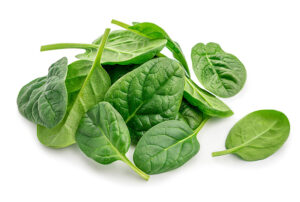By Anne Palumbo
 I never liked spinach as a kid, despite my crush on Popeye. But now that I have more candles on my birthday cake, enough to cause a divot, I’ve developed a true fondness for this leafy, green vegetable.
I never liked spinach as a kid, despite my crush on Popeye. But now that I have more candles on my birthday cake, enough to cause a divot, I’ve developed a true fondness for this leafy, green vegetable.
Loaded with nutrients and antioxidants, spinach benefits the body in so many ways, it’s often referred to as a “superfood.”
My devotion to this tasty green ramped up when a scan showed bone loss, and I was advised to increase my consumption of bone-strengthening vitamin K and calcium.
Although spinach has negligible amounts of calcium, it’s a vitamin K superstar, surpassing recommended daily needs in one cup. Vitamin K also helps blood clot properly.
Spinach packs high amounts of vitamin A. This workhorse nutrient may lower your risk of certain cancers, helps keep your immune system humming, reduces the risk of acne, and works hard to preserve your eyesight. Ever experience night blindness? It’s frightening! More spinach, please.
A diet rich in spinach also helps fight oxidative stress, an unhealthy condition that triggers accelerated aging and increases your risk of cancer, heart disease, diabetes and more. Spinach’s myriad of antioxidants—from its vitamins A and C to its many plant compounds—helps reduce the damage oxidative stress causes.
More good news: a recent study found that healthy seniors who had daily helpings of leafy green vegetables had a slower rate of cognitive decline, compared to those who ate little or no greens.
Lastly, spinach is an excellent source of folate, an essential B vitamin that is crucial for promoting a healthy pregnancy, turning carbs into energy, and synthesizing serotonin and dopamine, the “feel-good” neurotransmitters that keep us happy. So long, cabin fever!
Helpful Tips
For maximum vitamin retention—whether fresh or frozen—use quick-cooking methods that don’t include water (or very little): steaming, microwaving, stir-frying or sautéing. Frozen spinach retains more of its nutrients for a longer time than fresh spinach because of the lower temperatures at which it is kept. Lastly, check with your doctor before consuming spinach in any form, as its nutritional profile is not for everyone.
Healthy Spinach Artichoke Dip
Serves 6-8
 ½ cup nonfat Greek yogurt
½ cup nonfat Greek yogurt
1/3 cup fat-reduced cream cheese, softened
1/3 cup fat-reduced mayonnaise
1 tablespoon fresh lemon juice
¼ cup Parmesan cheese
2 garlic cloves, minced
1 teaspoon cumin
¼ teaspoon red pepper flakes (optional)
½ teaspoon Kosher salt
¼ teaspoon coarse black pepper
8 ounces frozen chopped spinach, thawed and drained
14 ounce can artichoke hearts, drained and chopped
¾ cup part-skim shredded mozzarella cheese
pita chips, crackers or crusty bread for serving
1. Preheat the oven to 375 F. Whisk the yogurt, cream cheese, mayonnaise, and lemon juice together until smooth. Stir in the Parmesan, garlic, and spices until well mixed, then stir in the spinach, chopped artichokes, and mozzarella.
2. Place mixture in blender or food processor and gently pulse until it reaches desired consistency. Spread the dip in an oven-safe baking dish and bake for 20 minutes.
3. Serve warm with crackers, chips, or crusty bread.
 Anne Palumbo is a lifestyle columnist, food guru, and seasoned cook, who has perfected the art of preparing nutritious, calorie-conscious dishes. She is hungry for your questions and comments about SmartBites, so be in touch with Anne at avpalumbo@aol.com.
Anne Palumbo is a lifestyle columnist, food guru, and seasoned cook, who has perfected the art of preparing nutritious, calorie-conscious dishes. She is hungry for your questions and comments about SmartBites, so be in touch with Anne at avpalumbo@aol.com.

